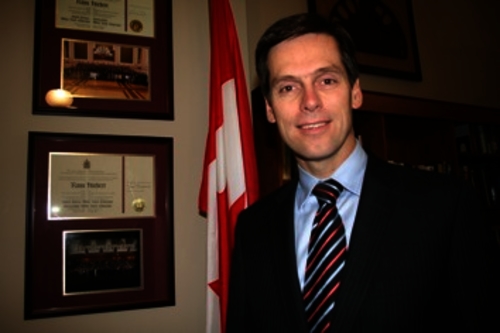
A Rising Tide Lifts All Boats: A New Cardus Survey of Homeschooling in Canada
December 14, 2012

Stockland does segment on the CBC’s <I> Cross Country Checkup</I>
Convivium Publisher, Peter Stockland contributes to Cross Country Checkup's annual Christmas list of good reading. To listen to Peter's conversation with Rex Murphy, click here. Peter can be heard at 1:11:21.
December 10, 2012

Peering into the Bird’s Nest of Public Service Unions
The Chicago teacher’s strike is over, but contention between governments and public service unions is far from over. In fact, given that industrial nations in Europe and North America are swimming in red ink and looking for savings at almost every level, it’s plausible that strife between public sector unions and governments will become the new normal. Labor strife in the public sector tends to be more divisive than strife in the private sector. The fault line often falls between those who think public sector unions are publicly unaccountable organizations which hamstring elected officials, and those who consider them the protectors of government programs, and thus protectors of the public good. But are these characterizations fair? How should we think about public sector unions? How do we make judgments about their activities in the public square and for their members? The usual place to start is to ask the question that those in labor relations have been asking since Freeman and Medoff wrote their famous book: what do unions do? But, as noted in an earlier article in these pages, this fails to provide a framework in which we can speak normatively about the actions of unions. The better question, I think, is what should a union do? And to answer that question, it’s necessary to ask what a union is. So, what is a union? The answer to that question is not as easy to answer as it seems. A labor union is a complex organization with a social function: It’s held together not primarily by law, but by the workers themselves who organize around the concept of solidarity or mutual support. Thus, even an organization like Solidarnosch, which was illegal in Poland, could still be considered a trade union. Likewise with workers’ organizations which existed prior to the Wagner Act. But it also has an economic function: One of its purposes is to ensure that workers earn enough money to put bread on their tables and pay for other necessities. Unions also have a legal role: to create and enforce rules which limit and shape the actions of not only workers but management. There is a reason why unions use (and, frankly, abuse) the word justice so much. A collective agreement is, after all, primarily a private legal contract. But, we also have to acknowledge that there is an element of power which is integral to unions. They exercise this power in a variety of ways, sometimes in ways that are right, and sometimes in ways that are wrong. Previously, I set out some guidelines by which we can evaluate how unions exercise their power in strikes, but that picture remains somewhat incomplete. A fuller picture will not only understand what unions are in their own right, but also their placement within the institutional structure in which they are embedded. How we think normatively about a trade union in the steel industry—with a major multinational business corporation like ArcelorMittal , for instance—will differ in some respects from how we think about a trade union at a hospital, a school or a major retailer. And, in turn, how we think about a trade union’s role in private hospitals will differ subtly from that of a union in a public hospital. And, as if things weren’t complicated enough, even among the public services, there are subtle differences between the way we think about trade unions. There is, for instance, a reason why the military is a strictly non-union environment! In each case, how we think normatively about trade unions and their action is shaped by the goal of the organization within which the union works. It is difficult, therefore, to offer too many blanket statements about the actions of public sector trade unions. But, within the confines of the space provided here, there is a basic point which will set the table for further reflection. When asking questions about public sector unions, especially in the United States, our evaluation of public sector trade unions must work hand in hand with our evaluation of the state. In other words, we must ask the question of whether the actions of a trade union reflect, help or hinder the state in its pursuit of public justice, and whether the actions of the state in relation to its employees are, in their own right, reflective of the same goal.
December 7, 2012

Joustra quoted in <I> The Catholic Register</I>
Editor of Cardus Policy in Public, Robert Joustra is quoted in The Catholic Register. He discusses the effects of government policy on NGO's and charities. To read the full article, click here.
December 6, 2012

<I> Comment </I> Editor, James K.A. Smith interviewed by OACS <I> News Service </I>
The Ontario Alliance of Christian Schools News Service asks Cardus' new Comment Editor, James K.A. Smith his thoughts on the state of Christian education. To read the full interview, click here.
December 6, 2012

Senior Researcher Brian Dijkema quoted in <I> The B.C. Catholic </I>
The B.C. Catholic covers Cardus' research on Bill C-377 from the June edition of CPiP, "Competition or Regulation? Reforming Labour Relations in Canada." Senior Researcher Brian Dijkema discusses the problems with the proposed private member's bill. To read the full article, click here.
December 4, 2012

Cardus researcher Brian Dijkema quoted in the <I> Daily Commercial News</I>
The Daily Commercial News profiles Cardus' latest research in Work and Economics, the Cardus Construction Competitiveness Monitor. To read the full article, click here.
December 3, 2012

Russ Kuykendall quoted in <I> Embassy</I> magazine
Russ Kuykendall, former Cardus research fellow, was quoted in Embassy magazine. The article, found here, references Kuykendall's piece "Clean Energy Superpower or Canadian Energy Strategy?", from the previous edition of Cardus Policy in Public.
November 15, 2012

Conservative bill forcing union disclosure is costly and inefficient
We would ask hard questions about someone who rushes to save a piece of burning toast while his kitchen is on fire. Likewise, questions must be asked about a government that spends enormous time and energy interfering with private institutions while millions of taxpayers dollars are being wasted on public construction projects in Canada. Those federal tax dollars are overspent annually on infrastructure projects due to restrictions on labour competition. At the same time, many unions spend the dues collected from their members on causes that do not have rank-and-file support. Both are real public problems that superficially seem different but are, in fact, intricately linked. Both are solvable through government policy aimed at greater accountability. The accountability can come from either effective government regulation or increased competition. Curiously, with legislation that might have come from the far left of the NDP in another context, Conservative MPs are choosing increased regulation rather than competition. They are earnestly promoting Bill C-377, which orders that any union expense over $5,000 be publicized to all Canadians, not just a unions members. The Parliamentary Budget Officer will conduct a cost analysis of the bill before it returns to committee in the next few weeks. C-377 tries to solve the problem of unions spending money on projects sponsoring Israeli apartheid days or funding student strikes in Quebec, for instance that have nothing to do with the work they should do. Yet its strict provisions outstrip, by a wide measure, the obligations imposed on charities or corporations. Its a classic case of government intervening in private associations of citizens while creating costly and ineffective regulation detrimental not only to union members, but to all taxpayers. Will the bill create greater union accountability? No. Its objective is to publicly disclose political activities. But most unions make no secret of their political involvements anyway. Last year, Ontario unions disclosed spending millions for political purposes through the Working Families Coalition, which filtered the funds into provincial Liberal election efforts. Union dues flagrantly supported one side in a political campaign. The real problem was not anything that would show up on a balance sheet. It was the army of union "volunteers" who ran campaigns all over Ontario at no cost to the Liberals. Yet provincial Progressive Conservative efforts to make it an election issue got no serious traction. Nor would the federal Conservatives Bill C-377 have prevented it. What the bill will do is drive unions to cover their flanks and increase consolidation. Larger unions can handle regulation and paper work. They are also far less likely to be accountable. They will move, like any large bureaucratic organization, toward central hubs of political power and work less for their base-line constituents. In other words, C-377 will work directly contrary to its supporters intentions. That leaves the alternative to regulation: competition. Ensuring greater competition among unions would force them back to the basics of representing front-line workers. Nothing promotes accountability like having someone ready to take your job or your business. It works for government. It works in the union world, too. Sadly, C-377 is more likely to snuff out the small, independent unions that are looking to innovate, reinvigorate and renew Canadas labour movement. The competition those smaller unions create is good for union members. It would also be a major benefit to taxpayers. A new Cardus study shows just how significantly union monopolies increase costs for municipal, provincial and federal infrastructure projects. For example, the federal government alone lost between $13-million and $53-million on the Union Station renovation in Toronto due to a construction labour monopoly. In Hamilton, the new Woodward Water Treatment facility cost federal taxpayers between $11-million and $46-million more than if there had been competition from multiple labour pools on the project. And that doesnt include costs incurred by the provinces or municipalities. Do the math. On two projects alone, thats $24-million to $99-million in wasted spending. Now weigh that against proponents of Bill C-377 fussing over $5,000 internal union expenditures. Which of these two should really concern Canadians most: the kitchen fire or the burning toast? The answer, surely, is for Conservative MPs to protect their constituents pocketbooks and jobs through wise stewardship of federal tax dollars. They should do so (and simultaneously solve Canada's union problems) by relying on conservatives bread and butter promoting competition rather than half-baked interventionist schemes.
November 12, 2012
Media Contact
Daniel Proussalidis
Director of Communications
